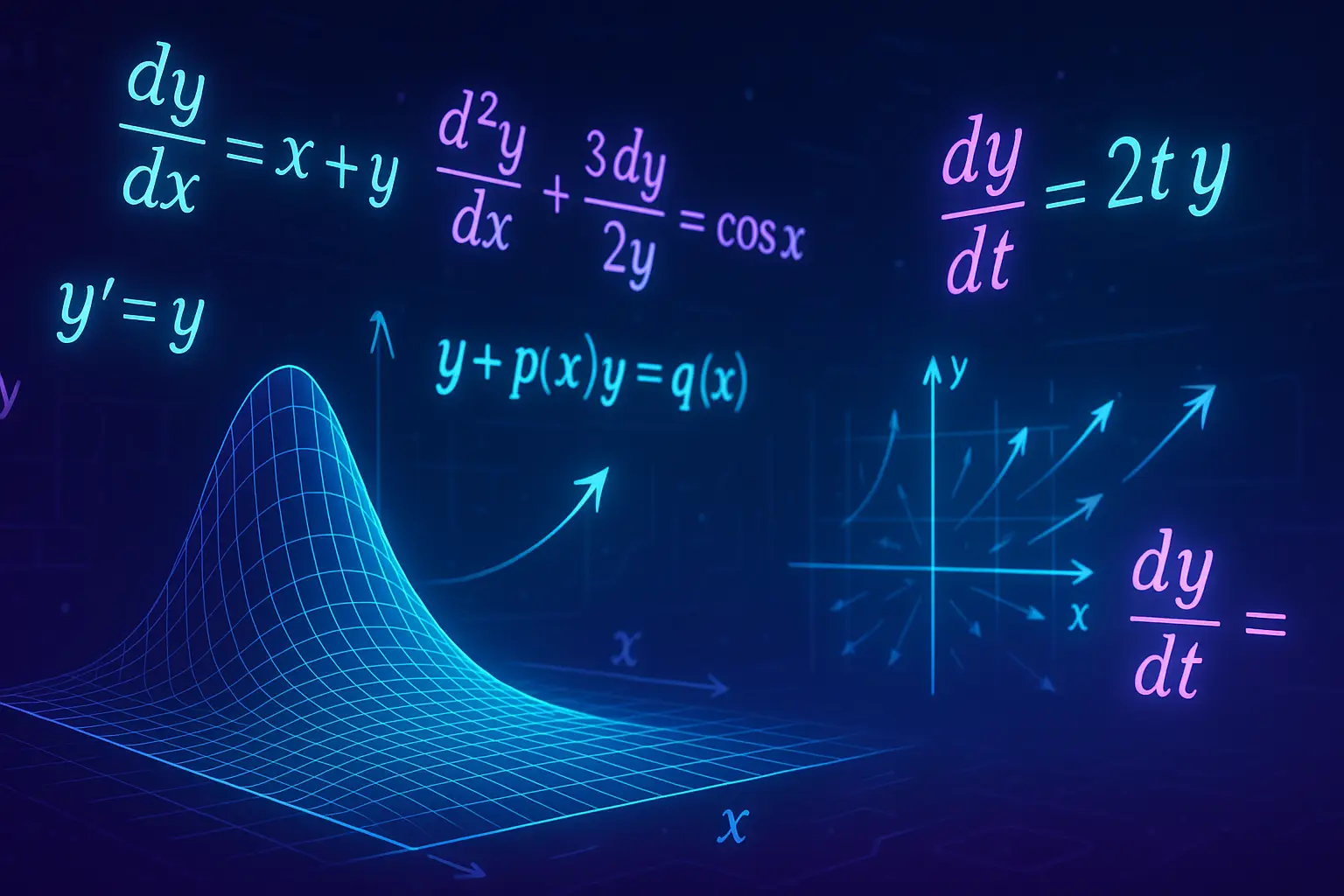Table of Contents
- Introduction
- What Is an Ordinary Differential Equation?
- Order and Linearity
- First-Order ODEs
- Separable Equations
- Linear First-Order Equations
- Exact Equations and Integrating Factors
- Second-Order Linear ODEs
- Homogeneous and Inhomogeneous Equations
- Characteristic Equation and Solution Space
- Method of Undetermined Coefficients
- Variation of Parameters
- Systems of First-Order ODEs
- Qualitative Analysis and Phase Space
- Applications in Physics and Engineering
- Conclusion
1. Introduction
Ordinary Differential Equations (ODEs) describe how a quantity evolves with respect to one independent variable — typically time or space. They are essential in modeling motion, growth, decay, oscillations, and fields in physics, biology, economics, and engineering.
2. What Is an Ordinary Differential Equation?
An ODE involves a function and its derivatives with respect to a single variable:
\[
F\left(x, y, \frac{dy}{dx}, \frac{d^2y}{dx^2}, \dots \right) = 0
\]
3. Order and Linearity
- Order: highest derivative present
- Linearity: linear if the dependent variable and its derivatives appear to the first power and are not multiplied together
Example:
- Linear: \( y” + 3y’ + 2y = 0 \)
- Nonlinear: \( y” + y(y’) = x \)
4. First-Order ODEs
General form:
\[
\frac{dy}{dx} = f(x, y)
\]
Can be solved via:
- Separation of variables
- Integrating factors
- Substitutions
5. Separable Equations
\[
\frac{dy}{dx} = g(x)h(y)
\Rightarrow \frac{1}{h(y)}dy = g(x)dx
\]
Integrate both sides to obtain the solution.
6. Linear First-Order Equations
Standard form:
\[
\frac{dy}{dx} + P(x)y = Q(x)
\]
Use integrating factor:
\[
\mu(x) = e^{\int P(x) dx}
\Rightarrow y(x) = \frac{1}{\mu(x)} \int \mu(x) Q(x) dx
\]
7. Exact Equations and Integrating Factors
An equation \( M(x, y)dx + N(x, y)dy = 0 \) is exact if:
\[
\frac{\partial M}{\partial y} = \frac{\partial N}{\partial x}
\]
Then there exists a potential function \( \psi(x, y) \) such that \( d\psi = 0 \). Otherwise, use an integrating factor to make it exact.
8. Second-Order Linear ODEs
General form:
\[
a(x)y” + b(x)y’ + c(x)y = f(x)
\]
If \( f(x) = 0 \), the equation is homogeneous; otherwise, non-homogeneous.
9. Homogeneous and Inhomogeneous Equations
- Homogeneous: solutions form a vector space
- Inhomogeneous: general solution is the sum of the homogeneous solution and a particular solution
10. Characteristic Equation and Solution Space
For constant coefficients:
\[
y” + ay’ + by = 0 \Rightarrow r^2 + ar + b = 0
\]
Roots \( r_1, r_2 \) determine the solution:
- Real and distinct → \( y = C_1 e^{r_1 x} + C_2 e^{r_2 x} \)
- Real and equal → \( y = (C_1 + C_2 x)e^{r x} \)
- Complex → \( y = e^{\alpha x}(C_1 \cos \beta x + C_2 \sin \beta x) \)
11. Method of Undetermined Coefficients
Used for inhomogeneous equations with \( f(x) \) like:
- \( e^{ax} \), \( \sin bx \), \( \cos bx \), polynomials
Guess a solution form, substitute, and solve for constants.
12. Variation of Parameters
General solution for inhomogeneous equation:
\[
y = y_h + y_p
\]
Where \( y_h \) is the homogeneous solution, and \( y_p \) is:
\[
y_p = u_1(x)y_1(x) + u_2(x)y_2(x)
\]
Found via integration using Wronskian.
13. Systems of First-Order ODEs
Written as:
\[
\frac{d\vec{y}}{dx} = A(x)\vec{y} + \vec{b}(x)
\]
Can be solved via matrix exponentials, diagonalization, or numerical methods.
14. Qualitative Analysis and Phase Space
- Equilibrium points
- Stability analysis using Jacobian
- Phase portraits visualize trajectories in state space
Used in nonlinear dynamics and control theory.
15. Applications in Physics and Engineering
- Harmonic oscillator: \( m\ddot{x} + kx = 0 \)
- RC circuits: \( V = IR + \frac{1}{C} \int I dt \)
- Radioactive decay: \( \frac{dN}{dt} = -\lambda N \)
- Newton’s laws: \( F = ma \Rightarrow \frac{d^2x}{dt^2} = \frac{F}{m} \)
16. Conclusion
Ordinary differential equations are the mathematical backbone of time-evolution problems in science and engineering. From simple decay to complex oscillatory systems, ODEs model the continuous change of systems in precise, analyzable form.
Understanding their classification, solution methods, and qualitative behavior is essential for anyone studying mathematical or physical sciences.


